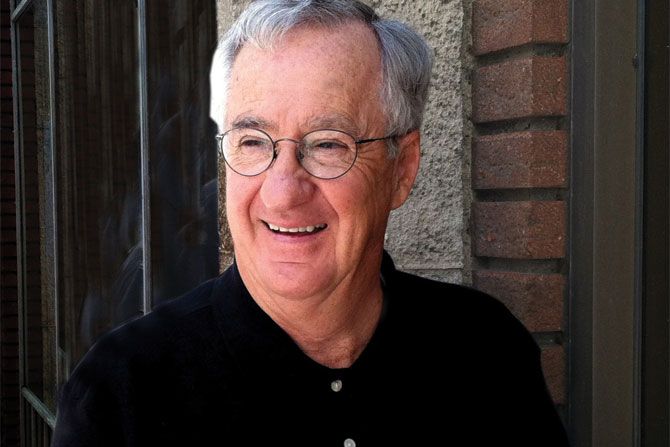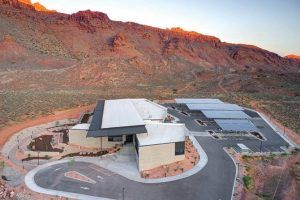Our second “Local Legends” interview in this issue is with Fred Babcock of Babcock Design Group. We appreciate the time he spent with us and are happy to share his story with you.
Fred, when did you decide to become an architect?
I was a junior in high school. Art had always been my passion. In high school, I was blessed to have an art teacher I responded to and enjoyed and learned from. One evening after class, I was sitting in the classroom doing some last-minute stuff on a project, and he came up to me, and he said, “Fred, what do you want to do when you grow up?”
I said, “Well, I’d like to do something connected with the arts. I’ve thought about maybe going into commercial arts. And he looked at me quizzically and said, “Are you sure?” I said, “Why do you ask?” He said, “I don’t know that too many of them make much of a living doing that. And I know you enjoy math. Have you ever thought of architecture?”I hadn’t. I was in a small town in Idaho. I didn’t know if there was an architect in the community, but when he said that, it got me pondering.
I graduated high school and was in my first year of college at Idaho State University, which had a fledging architecture department. Halfway through that first year of architectural studies, my professor called me into his office and said, “Fred, I’ve been thinking about you. I don’t think Idaho State is the place for you. I’d like to suggest you think about maybe furthering your education somewhere else.”
Where’d you go?
My dad and I did a little research and discovered that Roger Bailey had just come to the University of Utah. He had great credentials and a reputation and was beginning this program here. That got me to move to the University of Utah, which I ended up loving.
The first-year class that year at the University of Utah had 60 students, and not one of them was a woman, that would have been in 1957. Of that 60, I was the only one who continued on and actually graduated with that class. Others came back later to do it. It was an arduous program.
When did you graduate?
It was a five-year [program], and I graduated in 1962 with my Bachelor of Architecture. I then decided I might like to be involved in teaching. I applied to Columbia University in New York and was accepted. We had the scholarship, my brand-new wife had a job, and then we discovered we were going to have a baby.
We questioned if we wanted to travel clear across the country to New York City. I applied to the University of California in Berkeley and was accepted, and they accepted my AIA scholarship. I spent a year doing graduate work at Berkeley and, in 1963, received my master’s degree.
Then what happens?
1963 was an interesting time at the University of California. It was a great time to be there because you could be part of it if you wanted to, but you could walk on by, which I chose to do. It created a big upheaval; it was the hippie generation, and I visited several firms in San Francisco, but they weren’t looking for people. It was a difficult time to find meaningful employment. And San Francisco was, even then, an expensive place to live.
I looked into coming back home, and we had our first child at the end of that year. Becoming a father put a different slant on me looking at where I should go.
I was able to find employment with John Clawson, an architect in town, and spent a couple of years there. I had an opportunity to go from there to work with Don Panushka, which I enjoyed and found Jim Christopher there again. It was a very small firm at the time. I remember being paid the amazing wage of a dollar an hour.
Then I was able to join up with Boyd Blackner. Boyd was an interesting fellow. He had recently come back into the city, having worked for a well-known architect back east, Victor Lundy. He was intrigued with the use of interesting shapes using glulam beams. That was quite what set him apart from most of the architects in town at that time. I worked with him for two or three years. That’s when my life took quite a turn. Two good friends of mine from the University of Utah, Ralph Evans and Albert Christiansen approached me, wondering if I’d be interested in being a part of a small firm that they were going to organize. And that was really exciting to me. We were in the attic of the Aviation Club building on South Temple, way up at the top. There we were working, and trying to find work, and having
What type of work?
Well, whatever came our way, honestly, Ab (Albert) was quite interested in commercial work and government work, so he was able to get a few things in that area. Ralph loved doing residential work and found some of that. That’s where I lean, in the residential end of the practice. But way back then, Wally Wright came to us indicating he was interested in turning the old bus barns into a shopping center and would we be interested in that?
There things began to grow. We moved from the Aviation Club building into the top loft space in the old trolley barns. One Monday morning, I got a phone call at home telling me that Ab had passed away the day before. He had been mowing his lawn and had a heart attack, and he was gone. He really was the glue that held everything together. Ralph and I looked at each other and said, “What do we do now?” But we were blessed, and we kept at it. Ab had just started doing a home for Robert Redford at Sundance. I remember the days when Mr. Redford and his wife would come into our conference room. And because our conference room could be seen by the Trolley Square shoppers, it was interesting how quickly 50 people would be congregating around our conference room, trying to behave like they were just shopping.
Not too long after Ab had passed away, Redford called me and asked, “Would you take over the project?” And I was delighted to do that. I was already pretty busy with what I was doing, and his project became extremely intense. I was going back and forth to Sundance three and four times a week, trying to keep up with everything. We survived that and Trolley became a pretty successful place. Trolley had leased up all of the space they had, and we were in a pretty prime spot with our office. Wally came to us one day and said, “Guys, I can make more money leasing your space out to retail than you want to pay. Can you think about moving somewhere?”
We found six bays of historic space on Exchange Place. We took a big gulp, and John Pace and I bit the bullet and bought them. Ralph was having some difficulty with his work and asked if he could be excused. In 1985, John and I created what we called Babcock Pace. After five or six years with John, we decided to go our separate ways, and that’s when it became Babcock Design Group, which it is today, even without me.
Talk about the nature of your work and how that evolved over time.
I was drawn to residential projects. I love the relationship I created with the client. I loved the opportunity I had to do something that changed their lives in a positive way. I found that the most important thing in the successful practice of architecture was to create and maintain relationships. I never saw myself as a great designer. I never saw myself as being given awards and things. But I love that we could create relationships that went on and on.
One day I had a call from a real estate agent, a friend, who said, “Fred, I have a client that I’d like you to meet.” I was introduced to a wonderful Jewish couple from New York who had purchased a piece of land in Park City and wanted a home. They interviewed me and decided we should work together.
That became a life-changing experience. We did that home, and he called me one day and said, “Fred, are you ready to start over with another one? The one you just did, I’ve only been in it for six months, but a guy knocked on my door and wanted to pay me twice what I have in it. I just can’t turn that down. So, we got to do it again.” He found another piece of land, and off we went doing another wonderful home for him.
Then he said, “Fred, how would you like to do a building at Tufts University?” And I said, “Well, how would I? But how can that ever happen?” He said, “I want to introduce you to the rabbi of the Hillel at Tufts.” Well, here I am, a Mormon architect from Salt Lake, going back to Boston to meet with the Jewish rabbi and not knowing then what a Hillel even was. My friend, Marty Granoff, had decided that he was going to donate the money to build their Hillel at Tufts, and he wanted me to be the architect.
I had no idea what would lay ahead. I met Jeffrey Summit, the rabbi, and spent the whole day going all through New England looking at every Hillel we could. A Hillel, I found, was very much like an LDS Institute of Religion on our campuses here. It is a place for parents to have their kids go off to school and to feel like they’re going to be protected and nurtured and taken care of, and that intrigued me to be involved.
I had to meet the Dean of Tufts University, who was the head of construction. He wanted to meet with me and see our preliminary sketches. I was as anxious and nervous about it as any meeting I had had up to that point. I went into his office, and the first thing he said to me was, “What do I need with an architect from Utah?” And there was a part of me that had to agree. I got in my car, and I called my friend Marty, and I said, “Marty, I don’t think this is going to work, and I don’t want to get in the way of what you’re trying to accomplish here.”
He said, “Fred, have you ever heard of a Spalding?” He said, “When I was a kid in the public streets of Brooklyn, it was during the Second World War. There were lots of things that you couldn’t get. One of those things was rubber. Spalding made a little pink rubber ball that we used for everything we did. We played stickball with it. We threw it against the wall. We played every game we had, but no one else had a Spalding but me. If we got in an argument or they got mad, I just put the ball in my pocket and went home. So, this is my Spalding.”
Well, it turned out that it was. I suddenly became known as the Hillel architect. We then did another one at Brown University in Providence, and then another one in Maryland. I consulted in Florida: I consulted in California. I was traveling all across the country, helping people work out their Hillel plans. They would introduce me as their Mormon architect from Utah. It was really pretty humorous.
Tell me how architecture has changed since you began.
The reason I went into architecture was that I love to draw. Those were the moments that I most enjoyed, sitting down by myself and sketching with a pencil and bringing ideas out on paper. It is what it was all about.
When we started in Trolley Square, Ralph Evans, one of our partners, became enamored with what the computer industry was doing to our profession. I had no interest in it. One day I walked into the office, and there sitting by his desk was a big plotter. I think he paid $200,000 or something for it. I think he went way out on a limb, and I thought, “Ralph, what are you doing?” But he had more foresight than I did, obviously.
And then as, as we moved down into Exchange, everybody had to have a computer at their desk. Except me. It became inevitable that this is where it was headed. And for the first time in my life, I had the impression I was out of my league. I didn’t understand how computers worked. I didn’t have any interest in them. I just wanted to draw, and when they took the drawing component away from me, that was when I began to lose interest. And to see now what comes out of the computer is just staggering. But it left me behind.
How did you cope with that during that period?
I think I made it work by transitioning into the relationship component of the firm. I was never very strong politically, but over the years, I had been able to create relationships that were willing to be helpful to me.
For example, I’d been asked to do a home for Jon Huntsman and his family in Park City. That created a relationship with John that led to designing their Corporate Headquarters building in the Research Park and the Huntsman Cancer Institute.
I think the part of architecture that has remained constant is your relationship with people.
For those, like me, who think of architecture as being a place to express yourself with your hands, with the pencil, there is less opportunity. I think there are many very creative individuals who don’t like to draw. I find that discouraging because I think that’s where the essence of creativity comes from — internally through your fingers and into a pencil. And that seems to have disappeared. I’m quite surprised at how many young people come to interview for a position, when you ask to see their portfolio, they only have what’s on a computer.
Projects that you’re particularly proud of?
Multiple, multiple houses. I’ve had the opportunity to do some really fun and wonderful projects residentially. The Hillels we were involved in back East are a big part of my life. The first phase of the Huntsman Cancer Institute is another one that I hold in my memory bank.
What about disappointments?
Yeah. The ability to function within the political structure to win new work. That was just a very frustrating part of my practice. We were rarely successful in plowing through that terrain. The interviewing process is a huge part of that, and I was never very comfortable with that part of it. We were successful when we landed the Broadcast Center at the University, and Huntsman was an example of going through that process. But there are a lot of second places. Maybe that’s one of the reasons I spent so much time in residential work. I didn’t have to go through that process; also, working with commercial developers who would come to you, you didn’t have to go to them.
Advice for young people?
One of my employees some years back came in and stood in front of my desk and said, “Fred, I want to be like you. What do I do?” And the first thought that came to my mind was: Maintain and keep your relationships. That has been an important component, not only my practice, but I think my life. I want to maintain the relationships with people I care for and who I think care for me.
To watch the full interview, please click the link below.
https://www.youtube.com/watch?v=Iy8YBmNF6gA







